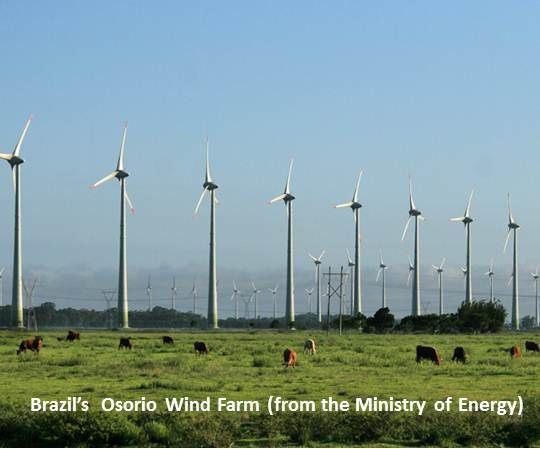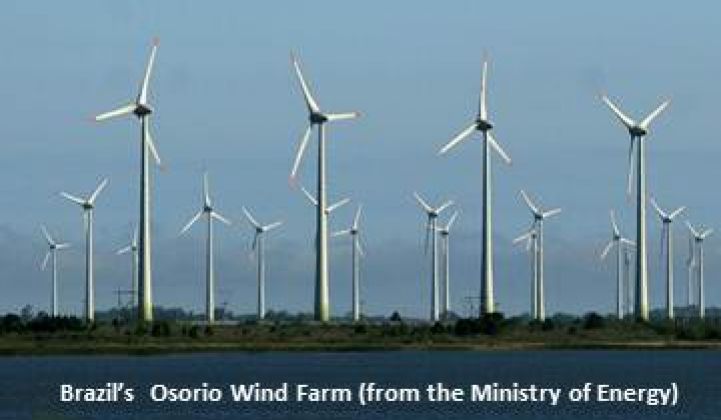In December 2009, the price of wind in Brazil -- derived in Ministry of Energy-supervised, regulated market auctions -- was 148 Reals ($91.93) per megawatt-hour. By December of the following year, the competitive price had fallen to 130 Reals ($80.75) per megawatt-hour. At that time, the Ministry revised its 2005 projection from a 2030 installed capacity of 5,000 megawatts to a 2020 installed capacity of 11,000 megawatts.
This summer’s National Electric Power Agency (ANEEL) auction saw wind’s price drop to 99.5 Reals ($61.79) per megawatt-hour. The best price for natural gas-generated electricity in the same auction was 103 Reals ($63.98) per megawatt-hour, an economy-turning event for a country that is one of the world’s major oil and gas producers.
The most recent auction resulted in contracts for 78 new wind projects in Brazil, representing 1,928 megawatts of new capacity. This came after contracts for some 6,000 megawatts of new wind capacity (nearly six percent of the country’s total electricity demand) were completed as the price fell in 2009 and 2010, according to Hamilton Moss, the Energy Development Director for the Brazilian Ministry of Mines and Energy and Brazil’s renewable energy czar.
It is clear from the results of the recent auction, Moss said, that the Ministry will soon again need to revise its projections for wind upward.

Present estimates put Brazil’s capacity potential at some 143,000 megawatts, but, Moss said, it could be twice that.
“Wind development in Brazil is a perfect demonstration of basic economic laws,” Moss explained. “With competition, we pushed the price down. With the price down, the expectation of growth in the long term rose. People became interested in building factories here, so we have a complete chain of producers here now and they have prospered.”
A 60% domestic content requirement has helped spur supply chain growth. German turbine maker Enercon’s subsidiary Wobben Windpower and Agentinian turbine maker IMPSA were in Brazil early on. They were followed by multinationals like GE, Siemens and Alstom. Danish world-leading turbine maker Vestas and Spanish giant Gamesa are among the most recent entrants. Most international turbine builders, including a number of Chinese companies, are expected to turn up soon.
As a result, Moss said, “there was more competition and it pushed the price down further.”
Brazil’s wind, Moss said, has prospered because 1) the resource is rich, 2) a previous incentive system drove enough early growth for planners and builders to gain invaluable experience, 3) the Ministry of Energy carefully sustains legal and regulatory stability and predictability, and 4) the auctions result in 15- to 20-year power purchase agreement-like contracts, another dimension of stability that encourages competitive aggressiveness in developers.
“In a word,” Moss summarized, “clear competition, clear rules, clear regulation, clear benefits for enterprise and clear long-term profits.”

Wind in Brazil, Moss said, “has proved we can combine clean, renewable energy with low price. And not just in Brazil.”
Two other factors, according to Moss, favor continued growth.
First, 76 percent of Brazil’s electricity comes from its rich hydropower resource and Brazilian wind’s variability perfectly complements the base load hydro supply. In the wind-rich northern and southern regions, there is an almost ideal match between wind and hydro, Moss said. "The best wind times are coincident with the worst water flow." During times of drought, this is particularly fortuitous.
Beyond this “complementarity,” Moss added, “We have an almost fully interconnected transmission system” and “the wind in the south is wholly complementary to the wind in the northeast.” With this robust 200,000-kilometer grid, wind-generated electricity can be moved around to minimize the impacts of variability.
Where there are wind resources far from a grid interconnection, the Energy Ministry encourages developers to share the cost of building one. “Every year we connect more of the country,” Moss said.



